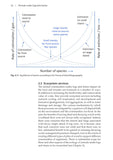
Animals under logs and stones
- Accessibly covers cryptosphere ecology and environment
- Easy-to-use, comprehensively illustrated keys
- Offers guidelines for study and ideas for further research
- ...there is something in this book to spark the interest of every enquiring naturalist.
—Paul T. Harding MBE
- ecology
- entomology
- identification
- invertebrates
- logs
- soil
- taxonomy
Description
Logs, stones and the like provide an interesting interface between the damp depths of the soil and the drier open ground surface, offering refuges for a fascinating array of animals. The communities of organisms that live beneath them are little noticed and even less studied, yet the potential for ecological work here is great. Some of the animals are relatively large and frequently not difficult to find. They exhibit a wide range of lifestyles – from slow slugs or snails to very fast centipedes, from generalist to specialist feeders and from herbivores to carnivores.
With chapters covering the cryptosphere environment, species groups, identification, guidelines and ideas for further research, this much-expanded and updated new edition also includes extensive, easy-to-use, comprehensively illustrated keys. Ground-surface debris can be found almost anywhere, often presenting highly accessible microhabitats for study and bringing immediate rewards to the curious: here is the ideal tool to unlock these worlds.
DOI: 10.53061/UXAG4304
Table of Contents
1. Introduction
2. Environmental conditions under logs and stones
3. The cryptozoa
4. Identifying the animals
5. Studying animals under logs and stones
6. Useful addresses and links
7. References and further reading
Index
Reviews
- Every aspect of observing, collecting and recording the diverse fauna that can be found under logs, stones and similar micro habitats is covered in this greatly expanded and extended 2nd edition. The authors have thought of everything, with apposite in-text references and a valuable bibliography, sampling techniques, guidance on equipment, health and safety and much more. Even if you never take the study of millipede or molluscs any further, there is something in this book to spark the interest of every enquiring naturalist.
—Paul T. Harding MBE - A really wonderful development of an original text that I have relied upon for many years. Most strikingly are the new illustrations, photographs, links to the underpinning research and updated keys making this an essential resource for my fieldcourses and undergraduate field projects.
—Prof. Mark Langan, Manchester Metropolitan University - As a lecturer in Zoology, invertebrate systematics is one of the most challenging subjects to teach. This is largely due to the wide range of specialist keys that are required to encompass a sufficient number of taxa. Animals under logs and stones solves this problem by bringing 25 different animal keys (22 of which are invertebrate keys) in one book. This book is a must for anyone who is interested in animal identification and biology.
—Dr Jaime Martin, Nottingham Trent University - The 25 identification keys that form the bulk of this guide will enable anybody – whether a novice or experienced ecologist – to identify animals ranging from tiny mites to small mammals. This comprehensive guide will enable prospective researchers to embark on much-needed field studies that will help to fill the many existing gaps in our knowledge.
—Dr Stephen Tilling, former Head of Policy and Advocacy Research, Field Studies Council - This second edition, at 352 pages (ca fourfold longer), is comprehensive and has been thoroughly updated using the most recent taxonomic divisions and information available... This book will interest those who are curious about hidden animals. Teachers would also appreciate this book, as it could be adapted for students from elementary to high school.
—Phyllis G. Weintraub, Community Ecology - An excellent and very useful book for naturalists, ecologists, ecological surveyors, or indeed anyone interested in knowing what lives in the hidden places of their garden. It caters well for the growing interest in and use of bug hotels and will help anyone establishing them to understand more about the animal communities they support.
—Alvin Helden, Anglia Ruskin University - A great addition to the library of any wildlife enthusiast who may want to observe the world of the invertebrates around them.
—Danniella Sherwood, Newsletter of the British Arachnological Society - If you are keen or just interested in turning over logs and stones (which most naturalists seem to enjoy or should do) then this is the book for you and its definitely worth upgrading to the new edition. Easily recommended.
—Roy Stewart, British Naturalist
About the Author
Phil Wheater is Professor Emeritus in Environmental and Geographical Sciences at Manchester Metropolitan University. After a long university career, he has semi-retired to follow his interests in the ecology and management of human-influenced environments, and invertebrate conservation and management. He has written several books on ecology and field techniques, is a keen advocate of field ecology, and continues to teach university students, including on field courses.
Dr Helen Read is the Conservation Officer for the City of London Corporation at Burnham Beeches, a National Nature Reserve in Bucks. She is an active member of the British Myriapod and Isopod Group having been Secretary and Bulletin Editor for many years and has previously served on the Council of the British Arachnological Society and been its Secretary. She is currently updating the Synopsis of the British Fauna volume on millipedes.
Charlotte Wheater is an artist who has produced illustrations for a range of outputs, including websites, research reports, infographics, and books.
Bibliographic Information
 352 pages
352 pages - 130 photographs, 280 line drawings, 52 charts and diagrams
- 10 tables
- BISAC SCI070020, NAT011000, NAT005000, NAT017000
- BIC PSVT, RNKH, WNCN






















